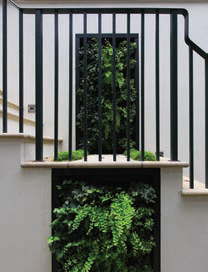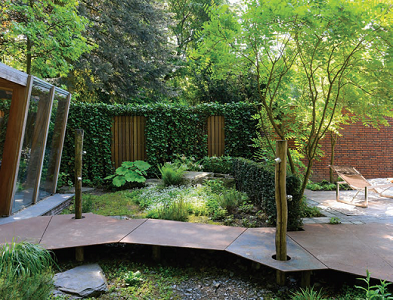Mary Hackett recounts the recent and much talked about GLDA seminar
Behind every well-designed garden, there is a team of talented and dedicated professionals: the Landscape Architect or garden designer, the landscape contractor and the nurseryman who take a site and a client brief from inception to reality. Each has a unique and essential role to play. The GLDA’s 2017 seminar explored their individual roles and the teamwork involved in ‘Completing the Picture’.

Summary of Speakers
● Sue and Bleddyn Wynn Jones, Crûg Farm Plants, Caernarfon, Wales
● Website: crug-farm.co.uk
Our first speaker was Bleddyn Wynn Jones who, with his wife Sue is owner of Crûg Farm Plants. This Welsh nursery has introduced an extraordinary range of plants to cultivation. The title of Bleddyn’s talk was ‘Collecting seed and plants in the mountains of northern Vietnam’.
The Wynn Jones first went to the mountain known as Fansipan in 1999 and have returned multiple times since. Another journey, this time in association with the University of British Columbia, is planned for April 2017. Fansipan is located in Lào Cai Province in Northwest Vietnam. At 3,143 metres (10,312 ft), the mountain is called ‘the roof of Indochina’. Collecting specimens in upland areas increases the probability of winter hardiness in Wales, as Bleddyn pointed out. Y Ty, the second area addressed in this talk, like Fansipan is cloud-covered for much of the year. The Red River, seen tumbling down a mountain gorge, showed how close the Chinese border is in this area.
The presentation included both descriptions of the plant material illustrated and observations on hardiness and ease of propagation of the species. As he outlined the plant’s characteristics, Bleddyn added his own assessment of the garden worthiness of the specimens. We saw how deforestation for the purpose of farming ginger is radically
changing the local ecosystem. There was a sense of urgency in the presentation – Bleddyn’s shot of the virtually unexplored virgin forest, clinging to limestone slopes, underlined the challenge facing this fragile environment.
Taking questions, Bleddyn noted that introducing new plants to cultivation is helped by shows such as Chelsea and also by working with both the National Trust in the UK (Mount
Stewart trials many species) and with Botanical Gardens all over Europe.
● Thomas Doxiadis, Architect, Landscape Architect ASLA, B.A. MArch, MLA
● Website: doxiadisplus.com
Our second speaker of the morning was Thomas Doxiadis, a Greek Landscape Architect with an international reputation. The title of his talk was ‘Utopia and Entopia in Mediterranean Landscapes’.
In 1999 Thomas founded the architecture/landscape practice doxiadis+ which prioritises environmental and landscape ecology principles in project design with a little added craziness. Sensitivity to existing built and ruined environment, textures, rocks, plants, trees, villages, goats and even snakes is central to Doxiadis designs. We travelled with
Thomas from the urban landscape of Dimosio Sima in central Athens, to the Greek Archipelago hotel resort on the Cycladic islands through a villa development on Antiparos in the southern Aegean, with side glances at a range of other public and private projects.
A recurring team was the balance between respecting the client’s desire for utopia and the designer’s commitment to entopia, a balance between the client’s wish for the Garden
of Eden and the Landscape Architect’s commitment to the expression of truth to place.
This was particularly evident in the villa development on Antiparos. Where a contemporary road would zigzag down the hillside, causing more destruction than the houses themselves, here access roads follow either the perpendicular lines of the xerolithies (dry stone walls) or the parallel lines of the pezoules (terraces). The vegetation strategy was equally sensitive. The patterns of existing vegetation were imitated by planting indigenous plant varieties in percentage mixes. Plants located closer to the houses were placed at a high density, giving clients the cultivated feel they required. Irrigation was only allowed for the house plantings. Planting away from the houses was graduated, allowing space for natural revegetation between the plants. Beyond a certain distance , o plants were introduced. The ideas for the project came from the site limitations, which Thomas emphasised was his preferred way of working.
Thomas also shared project designs for the development of Varkiza Didaclic beach outside Athens. His has a continuing interest in urban design and suggested some imaginative
developments including the redesign of urban streets as planted public park areas.
● Emma Mazzullo, Mazzullo and Russell Landscape Design, London
● Website: mazzullorusselllandscapedesign.com
Our first speaker of the afternoon was Emma Mazzullo who addressed her topic ‘Collaboration not Confrontation’ with verve. She emphasised that the private landscape designer can learn from procedures initiated by the commercial contracting industry. It is in the best interests of the whole team to work together to achieve delivery of design to a high standard, on time and within budget.
The value to the landscape designer of being on site early in the process was illustrated by suitably hair-raising project shots. Emma emphasised the value of working with the engineer and Architect, not only to agree practical issues like footings around the proposed building but also to manage the site so that damage to soil and landscaping elements
including existing trees is minimised.
As part of her presentation, Emma considered the developing practice of putting key landscaping plants into the tender for consideration by the client and inclusion in
the project budget. The importance of working with trusted nurserymen was central to her thesis. She observed that some shrubs required for the proposed Garden Bridge are
already being grown in Kent nurseries.
“We all want the same thing,” Emma said in conclusion. “A wonderful project, a happy client and a good journey. Collaboration will get us there.”
● Noël van Mierlo, Van Mierlo Tuinen, Deurne, Holland
● Website: vanmierlotuinen.nl
Concluding the seminar with an impressive presentation which included video clips and extensive overviews of his company’s work, Noël van Mierlo emphasised his commitment
to working with nature and his belief in the value of open-mindedness. His gardens aim to create a natural wellness experience in a space that gives the client joy. This is achieved
by bringing together nature, people and architectural skills.
He summed up his design principles as:
People
● Need a comfortable and private place where they can enjoy nature and celebrate life.
● Such a space should trigger adventure and curiosity. “As a designer, it is my business to guide my client to appreciate the details of the design.”
Nature
● A nature-sensitive garden should stimulate all the senses and embrace the people who live and play in it.
● To achieve this he aims to achieve authentic, natural planting and design.
Architecture
Nothing is more powerful than a well-designed structure created with care for detail and sensitivity for the landscape in which it is to sit.
● To achieve this he is meticulous about detail and uses pure, natural materials where possible.
● The overall message was that a garden must be built with craftsmanship, attention to detail and care. Work with specialists who love their job and can communicate well.
And finally, Noël delivered the most important advice of all – connect with your client.
In thanking all the day’s speakers, Patricia Tyrrell observed that every presentation was unique with the thread running through the day of a focus on nature, the fragility of the
natural environment and the importance of collaboration with both nature’s dictates and the skills of our fellow crafts persons to achieve successful landscaping projects. ✽





